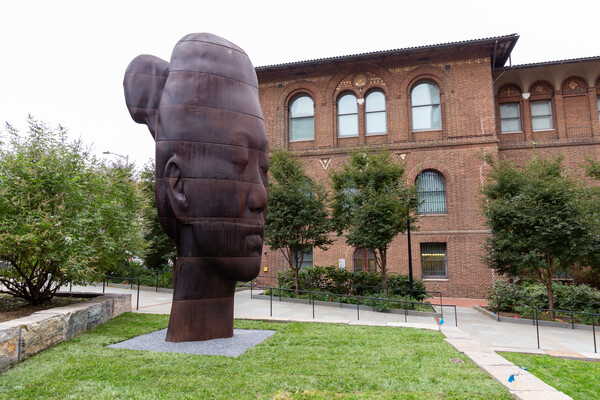
(From left) Doctoral student Hannah Yamagata, research assistant professor Kushol Gupta, and postdoctoral fellow Marshall Padilla holding 3D-printed models of nanoparticles.
(Image: Bella Ciervo)
The description of the photo collage in the lobby of Ryan Veterinary Hospital, “These unknown dogs are invisible, unnoticed unless you come close and look” bears two meanings. One is the literal experience of viewing “Fantine”: It appears at a distance to be an impressionistic rendering of a golden retriever, but up close one can see the faces of other individual dogs, nearly 500 of them. Then there is the symbolic meaning, that these once-invisible shelter dogs were noticed by the dedicated hospital staff.
The piece is a gift from Richard Lichter, whose charity enables shelter dogs with complicated medical needs that exceed the treatment capacity of shelters to receive the care they need at the University of Pennsylvania School of Veterinary Medicine through the Penn Vet Shelter Medicine Program. These are dogs who otherwise would have been euthanized, says Lichter, who is also a member of Penn Vet’s board of advisors.
“It’s all over the map,” he says of their conditions. “A lot of them had broken bones, through a car accident or some other sort of accident. There’s been hip dysplasia. There’s been cruelty cases, sadly, and a lot of parvovirus cases.”
These are some of the stories of the 500 dogs whose faces make up the visage of his golden retriever, Fantine, who died in 2022 at age 11. Fantine was treated for osteosarcoma later in life at Ryan Hospital. A picture of Lichter’s golden retriever before Fantine, Cosette, hangs in the Richard Lichter Emergency Room Lobby at Ryan Hospital.
Hyemi Sevening, associate dean of institutional advancement at Penn Vet, says the original idea was for the Fantine piece to be placed upstairs in the treatment areas. “We recognized that it needed to be in an area where it is visible and inspirational to all, to pet owners, to our clinicians, and to our veterinary students,” Sevening says. “It is particularly poignant to Ryan Hospital’s reception staff, who greet our clients and their pets during times of emergency or duress.”
Lichter says the inspiration for the Fantine collage came from Vik Muniz, a Brazilian artist who reimagines famous artworks using other images, found objects, and eccentric mixed materials. He bought a Muniz piece that recreates an Édouard Manet painting using images of other people’s faces. Penn Vet had been sending Lichter pictures of the dogs from shelters, and Lichter gave these to an artist to reformulate into Fantine’s likeness.
“I think it’s very uplifting,” he says. “Those dogs would not be alive, most of them, if it weren’t for Ryan Hospital because they all went through specialty treatment.”

(From left) Doctoral student Hannah Yamagata, research assistant professor Kushol Gupta, and postdoctoral fellow Marshall Padilla holding 3D-printed models of nanoparticles.
(Image: Bella Ciervo)

Jin Liu, Penn’s newest economics faculty member, specializes in international trade.
nocred

nocred

nocred